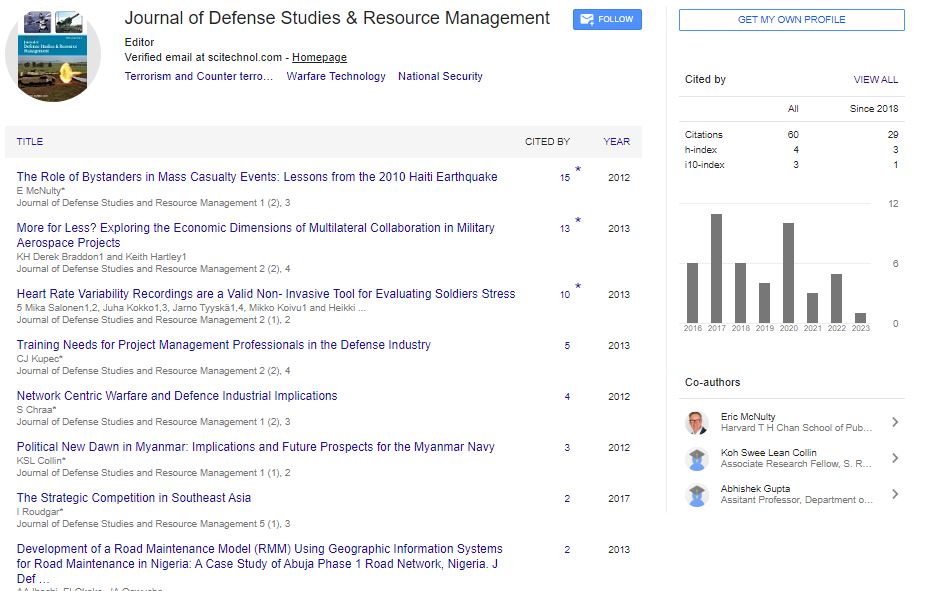Commentary, J Def Stud Resour Manage Vol: 11 Issue: 4
The Phalanx and Its Historical Significance
Andy Patricia*
1Department of Ancient Philology, Literatures and History, University of Bari Aldo Moro, Bari, Italy
*Corresponding Author: Andy Patricia,
Department of Ancient Philology,
Literatures and History, University of Bari Aldo Moro, Bari, Italy
E-mail: patricandy6@libero.it
Received date: 30 October, 2023, Manuscript No. JDSRM-23-12063;
Editor assigned date: 01 November, 2023, PreQC No. JDSRM-23-120623 (PQ);
Reviewed date: 16 November, 2023, QC No. JDSRM-23-120623;
Revised date: 23 November, 2023, Manuscript No. JDSRM-23-120623 (R);
Published date: 30 November, 2023, DOI: 10.4172/ 2324-9315. 1000191
Citation: Patricia A (2023) The Phalanx and Its Historical Significance. J Def Stud Resour Manage 11:4.
Abstract
The Phalanx formation was a rectangular mass of heavily armored infantry known as hoplites, typically armed with a large round shield (hoplon), a spear (dory), and a short sword (xiphos). These soldiers, often citizen-soldiers fighting in defense of their city-states, would stand shoulder to shoulder, forming a shield wall that covered the entire front line of the formation.
Description
The Phalanx formation was a rectangular mass of heavily armored infantry known as hoplites, typically armed with a large round shield (hoplon), a spear (dory), and a short sword (xiphos). These soldiers, often citizen-soldiers fighting in defense of their city-states, would stand shoulder to shoulder, forming a shield wall that covered the entire front line of the formation. The shields were held in the left hand, providing protection not only to the individual warrior but also to the right side of the comrade to their left. The strength of the Phalanx lay in its cohesion and discipline. The formation moved forward as a single, impenetrable unit, presenting a wall of shields to the enemy. The primary offensive weapon was the long spear or dory, held in the right hand and thrust over the shields of the front line. This combination of a shield wall and overlapping spears made it exceptionally challenging for enemy forces to break through. Moreover, the success of the Phalanx depended on the soldiers' ability to maintain a tight formation, move in unison, and stay disciplined even in the heat of battle. Training and camaraderie were crucial elements, and hoplites often trained together to perfect the art of maintaining the Phalanx.
Historical significance
The Phalanx formation became particularly prominent during the Classical period of ancient Greece, reaching its zenith in the 5th and 4th centuries BCE. It played a pivotal role in major battles such as the Battle of Marathon, the Battle of Thermopylae, and the Peloponnesian War. Notably, the city-state of Sparta was renowned for its skilled employment of the Phalanx, creating a formidable reputation on the battlefield. The Phalanx was not without its vulnerabilities, as it relied heavily on the discipline and training of its soldiers. The formation could be susceptible to flanking maneuvers or attacks from the rear. However, when executed with precision, the Phalanx was a powerful force that could withstand and conquer adversaries. The influence of the Phalanx extended beyond the borders of ancient Greece. Successive military cultures, including the Romans, adopted and adapted aspects of the Phalanx formation into their own tactics. The disciplined shield wall became a symbol of strength, unity, and resilience, echoing through the pages of military history.
Historical battles
Battle of Marathon (490 BCE): The Battle of Marathon, where a Greek phalanx successfully repelled a larger Persian force, showcased the effectiveness of the formation. Peloponnesian War (431–404 BCE): The use and adaptation of the phalanx were central to the military strategies employed during the Peloponnesian War between Athens and Sparta.
Conclusion
The Phalanx formation stands as a testament to the strategic brilliance and martial prowess of ancient Greek warriors. Its disciplined and cohesive structure allowed small city-states to stand against larger armies, influencing the course of history. The legacy of the Phalanx endures as a symbol of the indomitable spirit of those who fought in its ranks, forever leaving an imprint on the annals of military strategy and tactics. Over time, military tactics evolved, and the dominance of the phalanx gave way to more flexible formations, such as the Macedonian phalanx and the Roman legion. These transitions reflected changes in weaponry, strategy, and the nature of warfare.
 Spanish
Spanish  Chinese
Chinese  Russian
Russian  German
German  French
French  Japanese
Japanese  Portuguese
Portuguese  Hindi
Hindi 